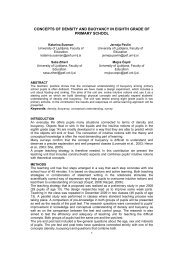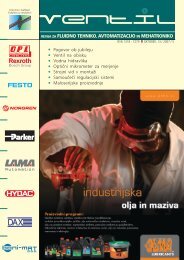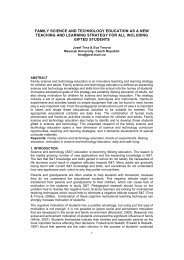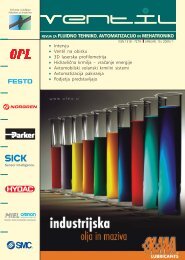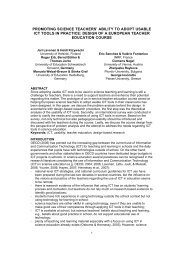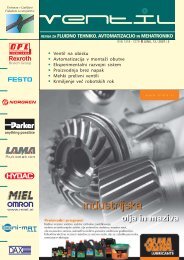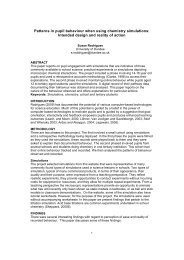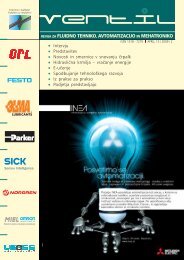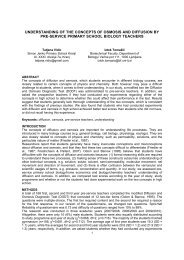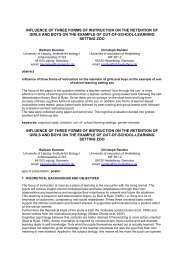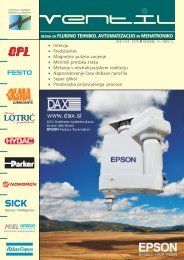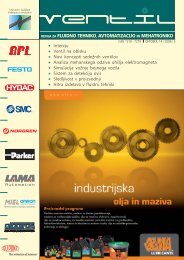1. PDF dokument (13 MB) - dLib.si
1. PDF dokument (13 MB) - dLib.si
1. PDF dokument (13 MB) - dLib.si
- No tags were found...
Create successful ePaper yourself
Turn your PDF publications into a flip-book with our unique Google optimized e-Paper software.
DISKRETNA SIMULACIJApercent,– average proces<strong>si</strong>ng time for anitem in production is forty-ninepercent. Average waiting time foran item is forty-three percent. Therest of the time, eight percent onaverage, is spent in transport.– decrease in number of productsbeing <strong>si</strong>multaneously present onthe conveyor results in a decreaseof the waiting time (obvious),– reduction in the number of operationsthat each machine can perform,results in increased waitingtime and in decreased transporttime.The results show also, that:– a reduction in the number of operationsthat each machine cancarry out results in increase ofwaiting time and in a decrease oftransport time.– the increase in the priority weightdoes not change the global results.Generally, in the first <strong>si</strong>mulated <strong>si</strong>tuation,the machine utilization rate isalways more than eighty-<strong>si</strong>x percent.In the second <strong>si</strong>tuation, breakdownconstraints were imposed. On average,the machine utilization rate, thetransport time and the waiting timedo increase. In general, a very goodrate of utilization for the machines(almost identical to the first case)has been obtained but the rate oftransport time has increased by thirtypercent. The best conditions for selfschedulingare observed in the casewhere duration of the operations isquite conforming. As a result, it isprofitable, if pos<strong>si</strong>ble, to group shortoperations in one operation and tosubdivide long operations.4 Conclu<strong>si</strong>onsIn this paper, a self-scheduling approachand control approach, in whichthe products as order-givers are autonomousand intelligent entities, hasbeen presented. Each product hasall the information on its manufacturingprocess (operation sequence,production rules, priority weight,due date) and has a direct access toinformation of all other entities. TheVentil 14 /2008/ 3results are very encouraging whenthis approach is applied, because themachine-utilization rate in both cases(normal case and disruption case) ishigh. Moreover, u<strong>si</strong>ng this approach,waiting time is short and a nearjust-in-time control is obtained. Theresults also show that our approachis able to schedule and control a<strong>si</strong>mple production system withouta prearranged schedule. This aspectwill be explored further.References[1] H. Brussel, J. Wyns, P. Valckanaers,L. Bongarts, P. Peeters,Reference architecture for holonicmanufacturing systems:PROSA. Computers in Industry,vol. 37, p. 255-274, 1998[2] H. J. Warnecke, The fractalcompany: a revolution in corporateculture. Springer-Verlag,Berlin, 1993[3] J. Peklenik, Complexity inmanufacturing systems. Manufacturingsystems , vol. 24/1, p.17-25, 1995[4] N. Okino: Prototyping of bionicmanufacturing systems,International Conference onObject-Oriented ManufacturingSystems, Calgary, Kanada, proceedings,p. 297-302, 1992[5] N. Okino: Bionic ManufacturingSystems, CIRP - FlexibleManufacturing Systems Past-Present-Furure, Ljubljana, p.73-95, 1993[6] R. Dindeleux, A. Lamia and A.Haurat. A Formal Modelling ofControl Processes control, EuropeanJournal of OperationalResearch, 1:306-309, 1998.[7] M. Jenko, Peter Mitrouchev,Daniel Brun-Picard, Managementof Distributed Productionfor Stochastic Events - ProductModel, submitted to Ventil,ISSN: <strong>13</strong>18-7279[8] B. Buchmeister, A. Polajnar andK. Pandza. Simulation study ofeffects of resources’ downtimeson shop performances, InternationalJournal of SimulationModelling, 1, 1:23-30, 2002.[9] A. Jain, P. K. Jain and I. P. Singh.Performance modeling of FMSwith flexible process plans - APetri net approach. InternationalJournal of Simulation Modelling,5, 3:101-1<strong>13</strong>, 2006.[10] D. Brun-Picard, H.A Baboli.Self-scheduling for FlexibleManufacturing Systems: a productoriented approach, Proceedingsof The <strong>13</strong>-th InternationalConference on ProductionResearch (E.M. Dar-El, R. Karni,Y.T. Herer Ed.), Freund PublishingCompany Ltd., London,England, 306-308, 1995.[11] A. Ferrarini, L. Couvreur andD. Brun-Picard. A new decentralizedapproach for F.M.S.control. Computer in de<strong>si</strong>gnmanufacturing and production,COMPEURO’93, IEEE ComputerSociety press. Los Alamitos,California, 410-416, 1993.[12] D. Brun-Picard, P. Mitrouchev.Production Synchrone EntreDonneurs d’Ordre et Soustraitants,Rapport d’activité pourl’année 3, mars 1997, Laboratoire3S, Grenoble.[<strong>13</strong>] P. Baillet. Contribution àl’amélioration de la réactivitédes systèmes de gestion de productionpar la mise en œuvredu concept de décentralisationdes fonctions de déci<strong>si</strong>on.Thèse de doctorat. Univer<strong>si</strong>téd’Aix-Marseille III, Marseille,1994.[14] H. Manier. Contribution aupilotage d’ateliers flexiblesréactifs, Thèse de doctorat,Univer<strong>si</strong>té de Franche Comté,Besançon, 1995.[15] M. Jenko. Queuing <strong>si</strong>mulationof distributed manufacturingsystems. Proceedings of the11th International Conferenceon Flexible Automation and IntelligentManufacturing : FAIM2001, Dublin City Univer<strong>si</strong>ty,16-18 July 200<strong>1.</strong> Dublin: DublinCity Univer<strong>si</strong>ty, vol. 2, p.694-705.AcknowledgmentAuthors collaborated in the frameworkof Virtual Research Laboratory– Knowledge Community inProduction, VRL-KCiP.249



